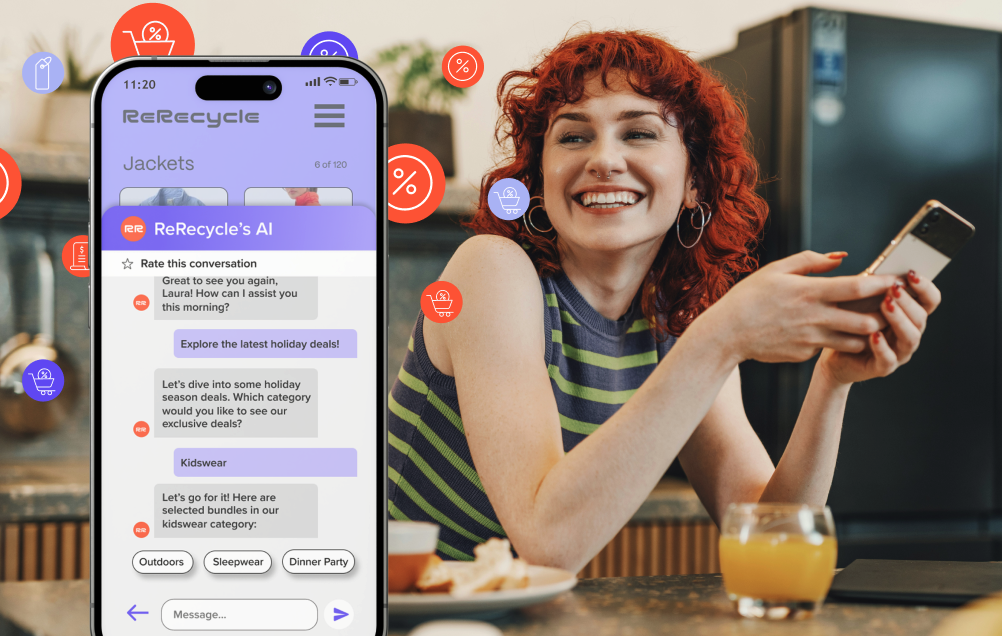eCommerce Needs a Brand Experience Overhaul—Here’s How You Do It
The last decade has been a rollercoaster for online retailers. The eCommerce industry took the world by storm in the mid-2010s after Shopify’s IPO. Just half a decade and one pandemic later, it's an essential platform to buy products and services during the pandemic.
Essential and lucrative — eCommerce sales brought in nearly $2.5 trillion from 2019 to 2022. But in the last few years, things have changed.
Online retailers got complacent, not adapting to changing consumer demands, economic factors, and emerging technologies. Now many eCommerce brand experiences fall short of expectations—and the allure is wearing off for consumers.
It’s hard to blame them.
Difficulty finding products, a lack of personalized service, and long wait times are just a few of the problems consumers face when shopping online. This leads to frustration, a lack of trust, and ultimately, a lost customer. With this in mind, it’s no surprise that the in-person shopping experience is making a comeback.
To thrive in the current eCommerce space you need to stand out from the competition, bring (and keep) customers on your page, and, of course, drive sales.
In short, you need to rebuild your digital brand experience from head to toe, delivering highly-personalized web experiences tailored to individual user needs in real-time.
It sounds like a daunting task, but we’re in the era of artificial intelligence—no more excuses.

Between the enhanced features of platforms like Shopify, tools like ChatGPT, and eCommerce AI assistants, you can create a truly engaging brand experience for your customers.
In this blog post, we’ll cover how a renewed approach to brand experience can give retailers like you an edge over the competition and help provide unique shopping experiences that customers won't forget.
First Thing’s First: Your Customers Crave a Seamless Brand Experience
Exceeding your customer's expectations is the key to creating a seamless brand experience — especially in online retail. The experts at Toptal call it “paving the path to purchase.” Just a few years ago, all this process required was a quality eCommerce UX, some solid marketing, and a responsive customer support team.
But that’s not enough anymore.
You need to provide an online retail experience that exceeds that of a brick-and-mortar store: anticipating customer needs, providing personalized solutions, and delivering consistent quality. This is how you build the trust and loyalty that sets your brand apart from the rest.
This is only possible if you are a bold and action-oriented business that is committed to staying ahead of the curve. You need to take the leap.
Investing in the latest technology, keeping up with industry trends, and listening to customer feedback can help you optimize your products and services and ultimately create a brand experience that your customers will love.
So instead of just keeping up with the competition, take a bold step forward and show your customers what a truly seamless brand experience looks like.
What is Brand Experience?
We all know how powerful brand reputation is to consumers in the digital era: the majority of consumers—82% in fact—make purchase decisions with a company’s purpose in mind.
But your company’s messaging is only one part of the puzzle that is your brand experience.
Brand experience isn’t just a logo or tagline, it's the lasting impression on your audience — or lack thereof. It's the sum of all interactions a consumer has with your brand, from the emotional response to images and messaging to the actual shopping experience itself. And the latter is particularly important for eCommerce.
Why? Well, think about it like this: even if a customer is perfectly aligned with a company’s message, are they still going to convert if they struggle to navigate your Shopify store or can’t find the right product? Probably not.
That’s why a complete brand experience is so important. It doesn’t just focus on marketing but incorporates four other essential elements to create the 5 X’s of brand experience.

A diagram illustrating Brand Experience (BX) with circles representing Marketing (MX), Customer (CX), User (UX), Employee (EX), and Data Experience (DX) surrounding it.
Marketing Experience (MX)
MX shapes the perception and expectations of a brand before a user even interacts with the company's products or services. It encompasses all promotional efforts, including advertising, public relations, and content marketing. MX is where you really show off your why.
eCommerce businesses typically drive the marketing experience with social media campaigns and targeted ads showcasing the store's products and communicating the brand's unique selling propositions.
With machine learning creeping into marketing analytics, these online retailers can enhance these campaigns by analyzing the behavior of leads, segmenting them, and automatically delivering personalized promotional emails.
User Experience (UX)
UX is the journey a user goes through to reach their goals with your product or service. The most established of the X’s, it refers to the ease of use, accessibility, and overall enjoyment a user has while navigating your website or using your product.
Good eCommerce UX typically involves a clean and intuitive website layout that allows customers to easily find products, read reviews, and complete purchases without any frustration.
But AI chatbots help you take UX efforts to a whole new level, especially for expanding brands.
Doe Beauty was a quick hit thanks to its superior product, but the team found that scaling online retail success was a whole different animal. But they didn’t make any excuses, opting for a conversational AI chatbot that has increased orders from first-time buyers by nearly 10%.
Customer Experience (CX)
CX is the overall impression a customer has after interacting with a brand through various touchpoints, including customer service, support, and other interactions. It's the lasting impression that sticks with a customer after their whirlwind romance with a brand, a sentiment that ultimately influences their loyalty and likelihood to recommend the brand to others.
CX for eCommerce stores is typically limited to email correspondence with a customer service team or clunky early-days chatbot. This is where in-person shopping often has the edge, with service reps immediately available to answer questions, troubleshoot issues, or have a friendly chat.
Thanks to ChatGPT and AI support assistants, eCommerce companies can provide a more personalized customer experience. Prime example: Vush. This sex toy eCommerce brand, is using a next-level AI chatbot that helps answer the common questions of first-time customers — with the brand voice to boot.
Data Experience (DX)
DX refers to the way a company collects, analyzes, and uses data to improve its products, services, and customer interactions. Essentially, it's the technological wizardry that takes all those numbers and stats and turns them into actionable insights and uses them to build better user experiences, more effective marketing campaigns, and more satisfying customer experiences.
Picture an eCommerce store equipped with data from previous visitor interactions to tailor the perfect product recommendations or predict when they are about to leave the site—DX makes that possible.
Employee Experience (EX)
Employee Experience (EX) is the perception and feelings employees have towards their workplace, which can have a significant impact on the overall brand experience. A positive employee experience can lead to more engaged and motivated employees who are committed to providing excellent customer service, support, and product quality.
In the context of an eCommerce store, a positive employee experience may include offering a supportive work environment, opportunities for growth and development, and fostering a strong company culture that prioritizes customer satisfaction.
Sometimes the best way to increase the EX of your team is by lightening the burden. Sales can be a difficult gig at the best of times, but selling luxury furniture products online? Well, that’s another level of stress. But if the 9% and 14% increases in CVR and AOV that eCommerce furniture brand Poly & Bark have experienced by using an AI sales rep is any indicator, SDRs might have a new best friend.
Creating the ideal eCommerce brand experience is no small task. Even with your A-team working around the clock, it’s still difficult to provide those personalized customer journeys that can bump you above the 2-3% industry average conversion rate.
Thankfully, you have a (not-so-)secret weapon at your disposal—one that can put all 5 Xs of your brand experience in hyperdrive.
AI shopping assistants.
How AI Assistants Enhance Brand Experiences in Real-Time
Modern consumers are on the hunt for something that goes above and beyond, and AI shopping assistants deliver just that.
With real-time data analysis and intelligent algorithms, AI assistants can tailor product recommendations, suggest complementary items, and even personalize the shopping journey for each individual user. By utilizing this technology, businesses can not only increase sales and customer satisfaction, but they can also gain valuable insights into consumer behavior.
So why wait? Get your free trial with Rep. Install eCommerce AI into your online store today with one click and watch your customers become raving fans of your brand.
Quick Answers and Applications
How can customer segmentation enhance personalized experiences and boost customer engagement in eCommerce?
Customer segmentation transforms eCommerce personalization by dividing your audience into distinct groups based on behaviors, preferences, and demographics. This strategic approach allows you to deliver tailored experiences that resonate with specific customer segments rather than using one-size-fits-all tactics. When implemented effectively, segmentation creates the personalized shopping experiences modern consumers demand—driving engagement, conversions, and loyalty.
Strategic Application
Customer segmentation enhances eCommerce personalization through four key approaches:
Personalized Customer Journeys
- Create segment-specific website experiences with targeted product recommendations and content
- Design custom email sequences that address the unique needs and interests of each segment
- Develop tailored post-purchase follow-ups based on purchase history and segment characteristics
Targeted Marketing Communications
- Craft messaging that speaks directly to each segment's specific pain points and motivations
- Allocate marketing budget to channels that perform best with high-value customer segments
- Develop segment-specific promotions that address unique purchasing triggers and barriers
Enhanced Customer Acquisition
- Build lookalike audiences based on your most valuable customer segments for more efficient ad targeting
- Create segment-specific landing pages that address the unique needs of different customer groups
- Develop lead magnets and offers tailored to the specific interests of target segments
Data-Driven Retention Strategies
- Identify at-risk customers within each segment and implement targeted win-back campaigns
- Create loyalty programs with rewards that appeal specifically to your high-value segments
- Analyze segment-specific feedback to address pain points before they lead to churn
How do loyalty programs and customer retention strategies drive sustained success in the eCommerce experience?
Loyalty programs and customer retention strategies are the backbone of sustained eCommerce success, creating a cycle of repeat business that traditional acquisition tactics simply can't match. When implemented strategically, these systems transform one-time purchasers into brand advocates, dramatically increasing customer lifetime value while reducing acquisition costs. But today's consumers expect more than basic points systems—they demand personalized experiences that recognize their individual preferences and purchasing patterns.
Strategic Application
Building effective loyalty and retention systems requires a multi-faceted approach:
Design Loyalty Programs with Clear Value Propositions
- Create tiered reward structures that provide escalating benefits as customers reach higher spending thresholds
- Implement points-based systems with transparent redemption paths and attainable rewards
- Offer exclusive perks like early access to sales or new products that can't be purchased outright
Optimize the Post-Purchase Experience
- Deliver personalized order confirmations and shipping updates that reinforce brand identity
- Create thoughtful unboxing experiences with care instructions and personalized thank-you messages
- Establish seamless returns processes that turn potential negative experiences into opportunities for connection
Maintain Brand Consistency Across All Touchpoints
- Align visual branding elements, tone of voice, and messaging across all customer interactions
- Ensure customer service representatives embody brand values in every communication
- Deliver consistent quality from product to packaging to create a cohesive brand story
Leverage Data for Personalized Engagement
- Analyze purchase patterns to deliver tailored product recommendations and communications
- Segment customers based on behavior and preferences for targeted retention campaigns
- Use purchase history to anticipate needs and proactively engage customers before they consider alternatives
AI shopping assistants transform these retention strategies by creating personalized shopping journeys that anticipate customer needs in real-time, turning standard loyalty programs into dynamic conversations that build genuine connections between customers and your brand.

.png)










